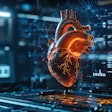Dear AuntMinnie Member,
One of the first clinical studies to be published using a new dual-source CT (DSCT) scanner for cardiac imaging has determined that the system overcomes many of the limitations found in even the current generation of 64-slice CT scanners.
In a series of presentations at this week's American Heart Association (AHA) meeting in Chicago, researchers from several European universities described their experiences with DSCT systems in a clinical setting. Staff writer Wayne Forrest was on hand to report for our Cardiac Imaging Digital Community.
In one study, German researchers used DSCT to examine patients with an intermediate likelihood of coronary artery disease, and measured its accuracy in ruling out stenoses. They found that the scanner produced excellent results in both sensitivity and specificity.
In a second paper, Dutch researchers evaluated the technology for detecting significant stenoses in patients referred for conventional coronary angiography. Like the German researchers, this group also gave DSCT high marks. Get all the details by clicking here.
In other news from the AHA show, U.S. researchers used B-mode ultrasound to assess the effectiveness of a pair of drugs in preventing thickening of the carotid artery wall in type 2 diabetes patients, in an article we're featuring here.
And cardiac MRI is the subject of an article available here on using the modality for detecting coronary artery stenosis.
Get all these stories and more coverage from the AHA conference in AuntMinnie's Cardiac Imaging Digital Community, at cardiac.auntminnie.com.



















